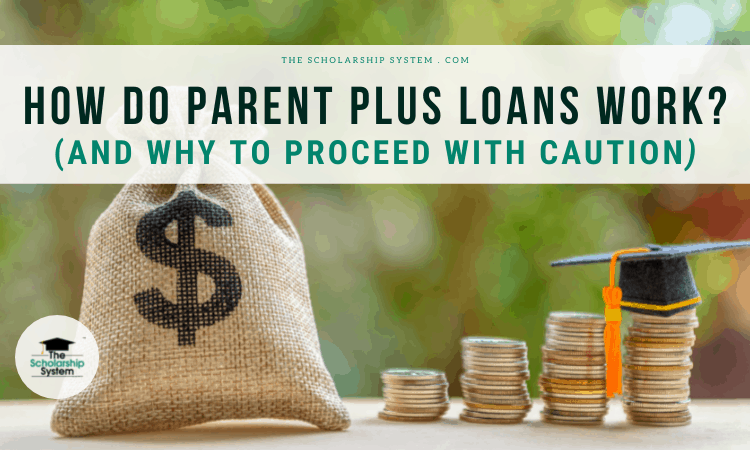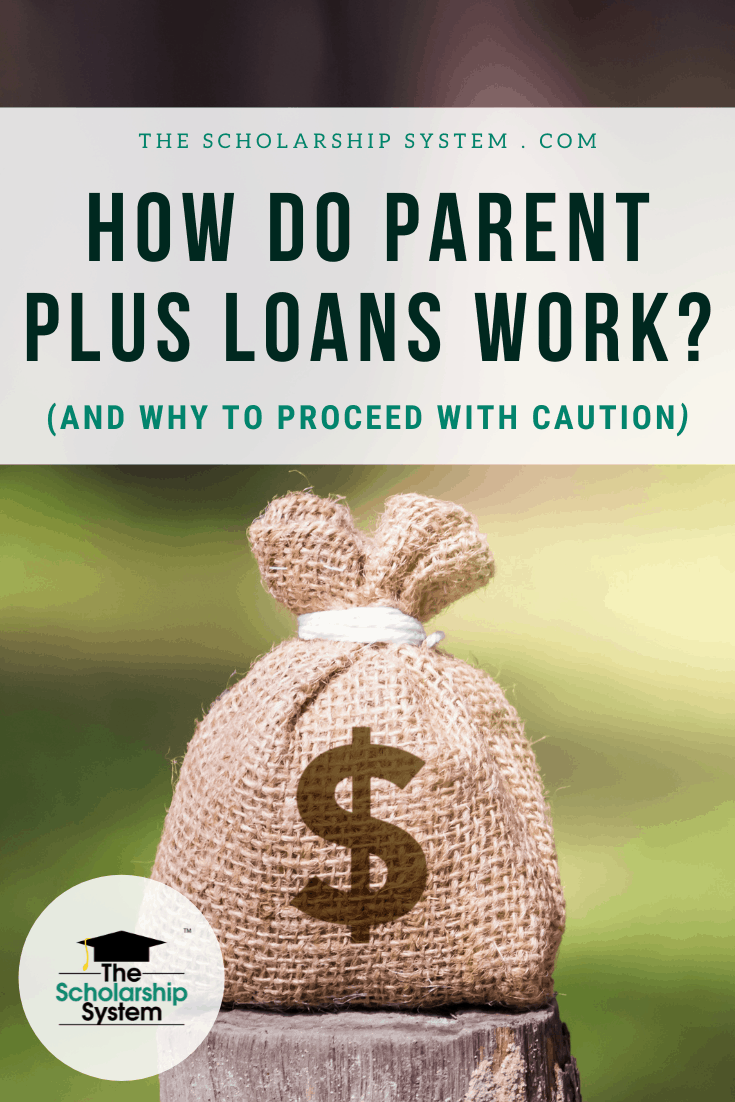Updated on May 20th, 2024
If your student’s financial aid package falls a little short, you may start wondering whether a Parent PLUS loan could be the answer. The money can be used on a variety of college expenses, including tuition, room and board, fees, and more.
However, while Parent PLUS loans are widely used and could be a reasonable solution, that doesn’t mean you shouldn’t proceed with caution. As with all debts, there are risks, and it’s important to understand what those are before you move forward.
While knowing how Parent PLUS loans work isn’t a bad idea, it isn’t the only option for handling the cost of college. Scholarships can make any school more affordable and don’t have to be paid back, allowing your student to potentially graduate debt-free. If you and your student want to learn more about finding scholarships, sign up for our free college scholarship webinar! Take a trip over to http://thescholarshipsystem.com/freewebinar to reserve your spot today.
If you’re wondering, “How do Parent PLUS loans work?” or simply want information on Parent PLUS loans, here’s what you need to know.
Contents
What Is a Parent PLUS Loan?
Parent PLUS loans for college are debt-based forms of financial aid offered through the federal government. Like with other federal student loans, the US Department of Education is essentially the lender.
With Parent PLUS loans, there are limits to how much you can borrow. Usually, your student’s cost of attending their chosen college or university plays the biggest role, as well as the other financial aid they are receiving.
In the end, a Parent PLUS loan isn’t meant to cover the entire cost of your student’s college. Instead, it’s a system that lets parents handle any financial gap their student may have after receiving their other approved financial aid.
Eligibility Requirements for a Parent PLUS Loan
According to the Department of Education, there are only three primary eligibility requirements for a Parent Direct PLUS Loan. First, you need to be the parent of a qualifying dependent student. Second, you must have suitable credit. Third, you and your student need to meet the general eligibility requirements for federal student aid.
General and Student Eligibility
When it comes to student eligibility for Parent PLUS loans, the requirements are fairly simple. Usually, as long as you have an undergraduate student who is enrolled at an eligible school at least half-time, you have this covered.
Additionally, you and your student need to be a US citizen or eligible noncitizen. There also has to be a demonstrated financial need, among other requirements.
In most cases, parents with students who already have an accepted FAFSA and initial financial aid package and that meet the requirements above are likely eligible to apply. However, no one is guaranteed to receive funding, as other factors do come into play.
Credit History
For most parents, the most complicated part involves their creditworthiness. The Department of Education uses an approach that differs from what you see from traditional lenders. Namely, it focuses on whether you have an “adverse credit history.”.
When you apply for a Parent PLUS loan, there is a credit check. You’re considered to have an adverse credit history if any of the following are discovered:
- Accounts with a cumulative balance of more than $2,085 that are at least 90 days delinquent, are in collections or have been charged off within the past two years
- Default determination within the past five years
- Bankruptcy within the past five years
- Repossession within the past five years
- Foreclosure within the past five years
- Federal student loan charge-off or write-off within the past five years
- Wage garnishment within the last five years
- Tax lien within the last five years
If any of those apply to you, you are not usually eligible for a Parent PLUS loan on your own. However, you may be able to get an endorser – essentially a co-signer – that isn’t your student who agrees to repay the loan if you’re unable. With that in place, you may then be able to qualify.
Additionally, if you can provide proof that the adverse credit history is related to extenuating circumstances, that may also allow you to become eligible. If that is the case, you can file an appeal online.
Minimum Credit Score for Parent PLUS Loans
When it comes to the credit score needed for a Parent PLUS loan, there isn’t actually a minimum credit score for a Parent PLUS loan. Instead, the Department of Education focuses solely on whether you have an adverse credit history and general eligibility.
How Do Parent PLUS Loans Work?
As with student loans, there can be some confusion when it comes to how Parent PLUS loans work. It isn’t like using a traditional lender, so there are some unique aspects to the process.
Applying for a Parent PLUS Loan
The foundation of the application process is the FAFSA. Your child needs to have a completed FAFSA on file for you to begin the process.
Next, your student needs to contact their chosen school’s financial aid office to determine what Parent Direct PLUS Loan application is required.
Typically, you’ll need to submit your request at StudentLoans.gov. The process is fairly straightforward, and you can get started by selecting the “Parent Borrowers” section on the home page and clicking “Apply for a PLUS Loan.”
As you complete the required process, you’ll need to select your student’s college or university from the list provided in the application, as well as supply any additional information requested on the application.
If you’re found to be eligible, you’ll need to sign a Direct PLUS Loan Master Promissory Note. With that, you’re showing that you officially accept the lending agreement.
It’s important to note that some schools use an alternative application process. If that is the case, the financial aid office may provide you with different instructions regarding their Parent Direct PLUS Loan procedures.
How Much Money You Can Receive Through a Parent PLUS Loan
Overall, the maximum amount you can potentially receive through a Parent PLUS loan is based on how much your student’s school costs and the value of their current financial aid package. A Parent PLUS loan is designed to only cover a gap, not the entire cost.
For example, if your student’s cost of attendance is $10,000 a year, and they are receiving $7,500 in financial aid, the maximum amount you could get as a Parent PLUS loan for that academic year is $2,500. That brings the total amount up to $10,000.
However, if that same student has access to no financial aid, then the parents could potentially borrow up to the full $10,000. In that situation, the cost of attendance and financial aid gap is the total cost, so a Parent PLUS loan could be issued that handled it all.
It is important to note that loan fees are proportionately deducted from every loan disbursement. Often, this is something that catches borrowers off-guard, so it’s crucial to keep it in mind.
How Parent PLUS Loan Funds are Disbursed
Parent PLUS loans disburse just like other federal student loans. Each payment is sent directly to your student’s school first, ensuring the funds are applied to costs like tuition, room and board, and other school fees.
If any funds are remaining, that is released back to you (or, with prior authorization, your student). Then, you can use the money to handle other qualifying expenses.
Parent PLUS Loan Deferment
With a Parent PLUS loan, you can either begin making payments right away (or as soon as the loan is fully disbursed) or request a deferment. With a deferment, you don’t have to make any payments while your student is enrolled at least half-time. Additionally, you get an additional six months after they stop meeting the attendance requirements before payment is due.
However, it’s important to note that if you defer, interest is still accruing on the loan. As it accrues, it capitalizes, essentially increasing the loan principal balance.
You do have the option of making interest-only payments during the deferral period, which can help you keep the balance under control. Otherwise, even though Parent PLUS loans typically have competitive interest rates, your balance can grow shockingly fast.
Parent PLUS Loan Repayment Plans
Like student borrowers, parents also potentially have access to more than one repayment plan. In most cases, this includes the:
- Standard Repayment Plan
- Graduated Repayment Plan
- Extended Repayment Plan
Each program may have unique eligibility requirements, so not all borrowers qualify for them all.
Through a Direct Consolidation Loan, you may also gain access to the Income-Contingent Repayment plan. However, that isn’t available when you initially secure a Parent PLUS loan.
Parent PLUS Loans Forgiveness
There are certain situations where Parent PLUS loan forgiveness, cancellation, or discharge may be available. Along with Public Service Loan Forgiveness and Teacher Loan Forgiveness, there are options for closed schools and total and permanent disability. Additionally, if you or your student passes, you may be eligible for Discharge Due to Death.
These aren’t the only potential situations where loan forgiveness, cancellation, or discharge might be an option. It’s wise to review the Federal Student Aid website to learn more about those options.
Why You Need to Be Careful with Parent PLUS Loans
While a Parent PLUS loan may seem like a good deal, it does come with risk. Here’s what you need to consider before moving forward.
Loan is Non-Transferable
While you may assume that you would be able to transfer the debt to your student since it funded their education, that isn’t the case. Parent PLUS loans are non-transferrable, so the original borrower remains responsible for the balance until it’s repaid.
Credit Report Impact
A Parent PLUS loan, like any other formal debt, appears on your credit report. As a result, the amount you owe, the size of your payment, and your payment history impact your score and perceived creditworthiness.
Since these loans can be sizeable, their simple existence may limit your access to other kinds of credit. Additionally, if you fail to make timely payments, that will also hurt your score, adding another layer of hardship to the equation.
The Risk of Default
Parent PLUS loans can be sizeable, leaving parents with a large debt they have to shoulder. Many borrowers struggle to repay the debt, particularly since the ability to repay isn’t factored into the lending decision, causing them to default.
Defaulting on a student loan of any kind has a serious impact on your credit. Additionally, a past due amount could prompt wage garnishments, tax refund seizures, and even money removed from Social Security payments.
Bankruptcy May Not Help
While many debts are dischargeable during bankruptcy, getting any kind of federal student loan discharged is shockingly difficult. First, it isn’t an automatic part of the process, requiring additional steps to pursue.
Second, you have to prove that the Parent PLUS loan specifically causes an undue hardship, not just today but over the long term. Since there are several repayment plan options, that can be incredibly difficult, if not impossible, in many situations.
Is a Parent PLUS Loan Right for You?
Ultimately, a Parent PLUS loan does come with risk. Before taking out any loan to help cover the cost of your student’s college, closely examine your financial situation. Consider whether you are comfortable shouldering a large debt over the long-term based on how it will impact your financial future. In the end, you’re responsible for repayment, so you need to keep that in mind.
After that, you can determine if it may be a reasonable option for you. In the end, the choice is yours. Just make sure you look at all the factors before you decide. That way, you’ll be comfortable with whatever you choose.
While knowing how Parent PLUS loans work isn’t a bad idea, it isn’t the only option for handling the cost of college. Scholarships can make any school more affordable and don’t have to be paid back, allowing your student to potentially graduate debt-free. If you and your student want to learn more about finding scholarships, sign up for our free college scholarship webinar! Take a trip over to http://thescholarshipsystem.com/freewebinar to reserve your spot today.









Leave a Reply